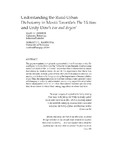| dc.contributor.author | Rasebotsa, N.L. | |
| dc.contributor.author | Lederer, M.S. | |
| dc.date.accessioned | 2011-11-22T10:29:31Z | |
| dc.date.available | 2011-11-22T10:29:31Z | |
| dc.date.issued | 2010 | |
| dc.identifier.citation | Rasebotsa, N.L. & Lederer, M.S. (2010) Understanding the rural-urban dichotomy in Mositi Torontle's the victims and Unity Dow's far and beyon', Research in African Literatures, Vol. 41, No. 3, pp. 21-33 | en_US |
| dc.identifier.issn | 0034-5210 | |
| dc.identifier.uri | http://hdl.handle.net/10311/926 | |
| dc.description.abstract | This paper examines how place is represented in two Botswana novels, Far
and Beyon’ by Unity Dow and The Victims by Mositi Torontle. Conventional
notions of rural as the “authentic” experience that is threatened by moral
breakdown in modern towns do not fit the experiences that these two
novels describe. Instead, place reveals attitudes that influence identity formation,
and it does so by foregrounding the importance of human relationships.
Thus, the important point is to restore and maintain a person’s sense
of belonging to a family and extended community, regardless of whether those communities are rural or urban. Breakdown threatens people when they do not know to whom they belong, regardless of where they live. | en_US |
| dc.language.iso | en | en_US |
| dc.publisher | Indiana University Press, www.iupress.indiana.edu | en_US |
| dc.subject | Rural-urban dichotomy | en_US |
| dc.subject | The victims | en_US |
| dc.subject | Far and beyon | en_US |
| dc.subject | Understanding | en_US |
| dc.title | Understanding the rural-urban dichotomy in Mositi Torontle's the victims and Unity Dow's far and beyon' | en_US |
| dc.type | Published Article | en_US |

